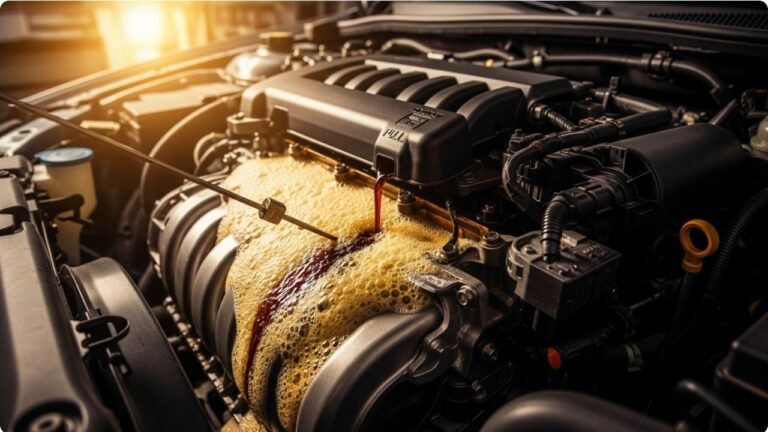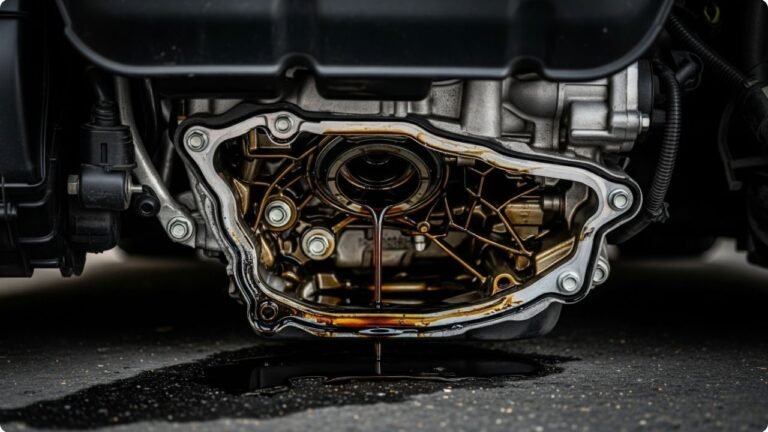What Happens If There Is Too Much Oil in Your Car?

Have you ever topped up your engine oil and wondered if a little extra might be a good thing? I did too—until one day, I learned the hard way. Believe it or not, putting too much oil in your car can be just as harmful as having too little. It’s one of those sneaky car maintenance mistakes that many of us make with good intentions, only to end up with a mess under the hood.
In this guide, we’ll explore what happens if there is too much oil in your car, the warning signs, possible damages, and what you can do to fix it. I’ll also share personal experiences, real-world tips, and practical advice that’ll help you avoid costly repairs. So grab a cup of tea, relax, and let’s get into the oily truth—because your car deserves better, and so do you.
In This Article
- 1 The Engine Oil Balancing Act: Why the Right Amount Matters
- 2 What Happens If There Is Too Much Oil in Your Car?
- 3 Warning Signs You’ve Added Too Much Oil
- 4 What Can Go Wrong?
- 5 Real-World Insight: Why It Happens More Often Than You Think
- 6 What Happens When There’s Too Much Oil
- 7 Is It Ever Okay to Slightly Overfill?
- 8 How to Check If You’ve Overfilled Your Oil
- 9 How to Fix Overfilled Engine Oil (Without Panicking)
- 10 Preventing the Problem: Smart Oil Habits to Follow
- 11 When to Worry: Red Flags That Need Attention
- 12 Real-Life Story: My Lesson with Too Much Oil
- 13 FAQs: What People Ask About Overfilled Oil
- 13.1 1. Can overfilling oil once ruin my engine?
- 13.2 2. How much is too much oil in a car?
- 13.3 3. Can overfilled oil cause white smoke?
- 13.4 4. Will the check engine light come on from too much oil?
- 13.5 5. Should I drive my car with too much oil?
- 13.6 6. Can a quick lube place overfill my oil?
- 13.7 7. How long can I drive with too much oil?
- 13.8 8. Is it expensive to fix an engine damaged by too much oil?
- 14 Final Thoughts: Don’t Let Too Much Oil Be Your Downfall
The Engine Oil Balancing Act: Why the Right Amount Matters

-
Reduces friction between moving parts
-
Keeps the engine cool
-
Traps dirt and debris
-
Protects against rust and corrosion
-
Ensures smooth performance
But just like too much water can drown a plant, overfilling your engine oil can suffocate your engine. When oil levels go beyond the maximum mark on the dipstick, pressure builds up. That pressure can push oil into places it doesn’t belong—causing serious trouble.
In short, the phrase “more is better” definitely doesn’t apply to engine oil. If you’re not careful, the aftermath can hit your wallet hard.
What Happens If There Is Too Much Oil in Your Car?
Let’s break down the chain reaction that starts when you pour too much oil into the crankcase. This isn’t some distant “might happen” kind of problem. It’s mechanical fact.
1. Oil Gets Aerated Like a Milkshake
Once there’s excess oil, the crankshaft ends up dipping into it as it rotates. That may not sound like a big deal—until you realize it starts whipping the oil into foam.
Foamy oil = bad lubrication.
And just like you wouldn’t wash your hands with bubble bath, your engine can’t run properly with frothy oil. It won’t coat parts evenly, leaving metal-on-metal contact that can lead to wear and tear or worse.
2. Increased Pressure Can Blow Seals
When oil overflows beyond its intended level, internal pressure shoots up. That excess pressure often looks for a way out—and it finds it by blowing through seals and gaskets.
Once a seal is broken, oil starts leaking. Not just little drips either. We’re talking puddles under your car, smoky engine bays, and sometimes even check engine lights lighting up like a Christmas tree.
One time, after an overzealous DIY oil change, I noticed a strong burnt smell. Turned out my valve cover gasket gave way from the pressure. A simple oil top-up turned into a messy, expensive fix.
3. Catalytic Converter and Spark Plug Damage
Here’s something most people don’t realize: Too much oil can sneak into the combustion chamber.
When that happens, oil starts burning along with your fuel. This can:
-
Foul your spark plugs
-
Clog your catalytic converter
-
Trigger that annoying check engine light
-
Decrease fuel efficiency
-
Reduce power and acceleration
Imagine your engine trying to breathe while choking on smoke. That’s what it feels like for your car.
4. Loss of Power and Poor Performance
If you’ve got too much oil in your car, you may notice it’s just not driving the same.
-
Sluggish acceleration
-
Engine hesitation
-
Jerky movement
-
Lower gas mileage
All these symptoms might creep in slowly—or hit suddenly like a wave.
I remember borrowing my cousin’s car once, and it felt like it was dragging itself uphill. He later admitted to “topping off” the oil two weeks in a row. You could actually hear the engine struggle.
Warning Signs You’ve Added Too Much Oil
It’s not always obvious at first, but your car does try to tell you when something’s wrong. Watch out for:
-
White or blue smoke from the exhaust
-
A strong burning oil smell
-
Oil leaking or pooling under the car
-
Check engine light or oil pressure warning
-
Rough idling or difficulty starting
-
A high reading on the dipstick
If you experience any of these, don’t wait. Too much oil in your engine can escalate into serious mechanical problems.
What Can Go Wrong?
Here’s a quick summary of what overfilling oil does:
-
Oil gets aerated, losing lubricating power
-
Crankcase pressure rises, damaging seals
-
Burned oil damages spark plugs and exhaust systems
-
Poor engine performance and fuel economy
-
Risk of engine failure if left untreated
Real-World Insight: Why It Happens More Often Than You Think
You might be wondering, “How does this even happen? Isn’t there a max line?”
Yes, there is—but sometimes people don’t:
-
Check the dipstick after adding oil
-
Park the car on level ground
-
Wait long enough after running the engine
-
Read the manual’s actual oil capacity
Another common reason? Mechanics or quick-lube places rushing through oil changes. I’ve seen cars leave shops with oil levels far above the max line, simply because someone poured in a rounded-up estimate without double-checking.
What Happens When There’s Too Much Oil
| Problem | Cause | Result |
|---|---|---|
| Frothy Oil | Crankshaft contact with excess oil | Reduced lubrication |
| Seal and Gasket Blowouts | Excess crankcase pressure | Oil leaks, burning smell |
| Spark Plug Fouling | Oil enters combustion chamber | Misfires, engine hesitation |
| Catalytic Converter Clogging | Oil burning in exhaust | Decreased efficiency, emissions problems |
| Reduced Power | Engine working harder to overcome resistance | Poor mileage and slow acceleration |
| Engine Failure (long-term) | Continuous wear from poor lubrication | Total engine breakdown, costly repairs |
Is It Ever Okay to Slightly Overfill?
This is a question I get asked a lot—especially by new car owners. And I get it. When the dipstick is just barely over the “full” line, it’s tempting to think it’s harmless.
Here’s the truth:
-
A tiny bit above the line (1-2mm) probably won’t cause damage
-
But more than half a quart over? Now you’re in risky territory
Most manufacturers design engines with a little tolerance. But why take the chance when your engine’s health is on the line?
How to Check If You’ve Overfilled Your Oil
You can easily check your engine oil level with these steps:
-
Park on a flat surface and wait at least 5 minutes after shutting off the engine.
-
Pull out the dipstick, wipe it clean, and insert it back fully.
-
Remove again and read the level:
-
If it’s past the MAX mark, you’ve added too much.
-
If the oil looks milky or foamy, aeration has begun.
-
A tip from experience? Do this at least once a week, especially if you’ve recently topped up or changed oil.
How to Fix Overfilled Engine Oil (Without Panicking)
So, you’ve realized you’ve added too much oil. Don’t panic—it’s fixable. The key is to act fast before the excess starts causing long-term damage.
Here are a few ways to correct it:
1. Use an Oil Extractor (Easy DIY Method)
An oil extractor, or suction pump, lets you remove the excess oil through the dipstick tube. It’s clean, quick, and doesn’t require crawling under your car.
Steps:
-
Insert the tube into the dipstick hole
-
Create suction using the pump
-
Remove small amounts and check the dipstick each time
-
Stop once oil reaches the proper mark
2. Drain from the Plug (For Larger Overfills)
If you’ve overfilled by more than a quart, draining from the oil pan may be more effective.
Steps:
-
Let your engine cool
-
Place a catch pan under the drain bolt
-
Loosen the plug slowly (don’t remove it completely)
-
Let out small amounts and recheck the dipstick
-
Tighten the plug once you’re at a safe level
Warning: Draining too much may force you to top off again, so go slow!
3. Visit a Mechanic (If You’re Unsure)
Sometimes it’s better to let the pros handle it—especially if you’ve already driven the car and noticed issues like smoke or leaks. A trusted mechanic can:
-
Drain the right amount
-
Inspect for damage
-
Reset warning lights
Preventing the Problem: Smart Oil Habits to Follow
Here’s how to keep your oil levels in the sweet spot every time:
-
Know your car’s oil capacity. It’s in your owner’s manual. Follow it to the letter.
-
Always use the dipstick. Don’t trust guesswork.
-
Check oil when the engine is cool. Hot oil expands and gives false readings.
-
Wipe and recheck. Always double-check after wiping the dipstick clean.
-
Keep a maintenance log. Track oil changes, top-ups, and what type of oil you use.
-
Don’t add “just to be safe.” If your oil is near full, let it be.
-
Ask questions at the shop. After an oil change, verify the level before leaving.
When to Worry: Red Flags That Need Attention
Sometimes, even after removing excess oil, the damage may have started. Here’s when you should take the issue seriously and see a mechanic ASAP:
-
Oil leaks persist even after fixing the level
-
Engine misfires, knocks, or idles roughly
-
Check engine light won’t turn off
-
You notice blue exhaust smoke
-
MPG (miles per gallon) drops significantly
-
Your car feels slower or less responsive
If you’re seeing these signs, don’t delay. The sooner it’s handled, the better your engine’s chances of full recovery.
Real-Life Story: My Lesson with Too Much Oil
Let me share something personal.
A few years back, I was prepping for a road trip with friends. I checked my oil—just slightly under the full line. Thinking it was better to be safe than sorry, I added almost half a liter more.
About 40 miles into the drive, I noticed a burning smell. Then, white smoke started puffing out the back. We had to pull over on the highway.
Turns out, I had overfilled the oil. The extra pressure blew my valve cover gasket and soaked the spark plugs. That trip cost me more in repairs than the whole vacation budget.
Since then, I never top off blindly. Lesson learned: when it comes to engine oil, more can definitely be worse.
FAQs: What People Ask About Overfilled Oil
1. Can overfilling oil once ruin my engine?
Not necessarily, but it can. If you haven’t driven much yet, drain the extra oil ASAP. If you’ve already driven long distances, check for damage signs.
2. How much is too much oil in a car?
Anything more than 1/4 to 1/2 quart over the max line is risky. Even small excesses can cause foaming and pressure buildup over time.
3. Can overfilled oil cause white smoke?
Yes. White or bluish smoke from the exhaust is often a sign of burning oil, which can happen if too much oil leaks into the combustion chamber.
4. Will the check engine light come on from too much oil?
It can. Especially if oil affects your spark plugs, sensors, or exhaust system. The computer detects abnormalities and throws a code.
5. Should I drive my car with too much oil?
If it’s just slightly over, you might be okay for a short distance. But if it’s more than 1/2 quart over, don’t risk it—remove the excess first.
6. Can a quick lube place overfill my oil?
Absolutely. It’s more common than you’d think. Always check the dipstick before leaving the shop to make sure your levels are correct.
7. How long can I drive with too much oil?
You shouldn’t. Even a short drive can whip oil into foam or cause leaks. Drain the excess as soon as possible.
8. Is it expensive to fix an engine damaged by too much oil?
If caught early, not at all. But if you ignore it and damage the catalytic converter, gaskets, or engine internals, it can run into thousands of dollars.
Final Thoughts: Don’t Let Too Much Oil Be Your Downfall
Cars are a lot like people—they work best with balance. And that includes engine oil levels. While we often worry about low oil, too much oil in your car is just as dangerous—and often more damaging because it’s not talked about enough.
The good news? It’s easy to avoid with a little awareness and routine checks. Know your car. Know your limits. And remember: when in doubt, always check the dipstick before and after adding oil.
Treat your engine like you’d treat your own body—with care, attention, and the understanding that more isn’t always better.






